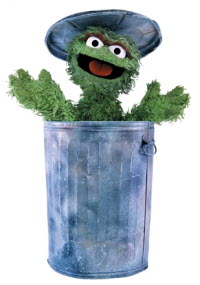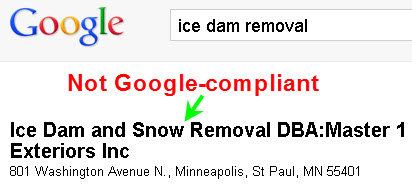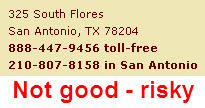I’m always telling you what you should add to your Google Places page and your website in order to rank visibly to local customers. But what about the stuff you shouldn’t include? What should not be on your Places page or website?
As perhaps you’ve noticed by now, getting visible in Google is largely a process of communication. You’re trying to tell Google certain facts about your business, in order to rank as highly as possible in your local market. If you communicate clearly, you’re more likely to get what you’re after.
(Of course, Google won’t do everything you hope it will: if you stuff your Places page and website with 50 keywords that you want to get visible for, you’ll be disappointed.)
 So what you need to do is eliminate mess from your “local presence. You need to remove online clutter that can trip up Google and hurt your local rankings or (worse) earn your listing a suspension. There’s a lot of garbage floating around Google Places and the rest of the Web, and it can hurt your local visibility to customers.
So what you need to do is eliminate mess from your “local presence. You need to remove online clutter that can trip up Google and hurt your local rankings or (worse) earn your listing a suspension. There’s a lot of garbage floating around Google Places and the rest of the Web, and it can hurt your local visibility to customers.
The good news is cleaning up is easy and quick. It may be all that’s necessary (a) to resolve any suspensions by Google or (b) to give you the visibility boost you’ve been looking for, or both.
Here are the areas I suggest you pay attention to and clean up if need-be:
To remove from your Google Places page / account:
- Remove duplicate Google Places listings (that is, multiple listings of the same business). If any duplicates show up when you’re logged into your “Dashboard,” get Google to delete them. Then go to Google and search for your business by name, in order to find any unverified duplicate listings that you may not have known about (and probably never created personally). Try to get those removed, too (here’s an excellent post that might help with this).
- Kill off any extra phone numbers on your Places page. There should only be one number on your Places page—and it had better use a local area code. Don’t include additional phone numbers anywhere on the page (fax numbers are OK).
- Remove city/town names from the name of your Places page (unless they’re part of your real DBA) and from your “Categories” fields. Google sees the inclusion of these as a spam tactic. Obviously, many businesses get away with keyword-stuffing, but I’ve also seen a number of listings get suspended for it.
- Scrub out any extra search terms (“keywords”) from your business name. As with the location names, search terms are OK to include in the “Company/Organization” field of your listing Google if they’re actually part of your real business name. Otherwise, you risk getting your listing pulled.

- Get rid of redundancies between your “Categories” and your “Description.” If you select “Landscaping Design” as a business category, don’t call yourself a “landscaping design specialist” in your description, and vice versa.
- Remove or edit “Additional Details” fields that contain keywords or location names that appear in the “Categories” or “Description” areas of your Places page.
To remove from your website
- Remove all crawlable phone numbers OTHER THAN the one you use for your Places page. For instance, if you have a line of text that contains a phone number that isn’t the one you list on your Places page, you’ll confuse Google. The only way you can include additional phone numbers on your site without gumming up Google’s bots is to add them as images—not as normal, “readable” text on your site (you know text is readable if you can highlight, copy, and paste it). Of course, even if you include additional phone numbers as images, you’ll want to think hard about whether their presence might confuse would-be customers.

- Shorten any parts of your title and description tags that are LONGER than 70 and 155 characters, respectively. Make your title and description tags fit within those character lengths, or else customers won’t be shown the excess parts in the search results. I haven’t seen evidence that excessively long meta tags harm Google Places rankings, but the name of the game is to attract customers. Customers are less likely to visit your site—whether it appears in the organic or the “blended” Google Places search results—if they can’t even read your entire title / description tags.
- Eliminate repetition in your title and description tags. Don’t have your title tag read “Austin plumbing, Austin plumber, plumbing company Austin TX” and so forth. It doesn’t help your rankings in the least, and it’s just gibberish in the eyes of potential customers. This is particularly true of the title tag: Fewer people will visit your site or Places page (sometimes the title tag appears as your business name in the Google Places “7-pack”) if your title tag is keyword mush.

Also, I suggest you check the major third-party sites (Yelp, SuperPages, InsiderPages, etc.) and data-providers (particularly InfoUSA) and try to remove any duplicate or inaccurate listings that these sites have for your business. These usually contain inconsistent info about your business, which can really ding your Google ranking. Depending on the specific site, trying to get these unwanted listings removed can be even more of a hassle than trying to wrangle with Google to get unwanted Places listings removed. Still, it’s something you always have to be patrolling around for and trying to weed out.
Oh, and one last thing: the items I just mentioned largely don’t even deal with the human element—that is, making sure your Google Places listing or website doesn’t contain any “junk” that might repel would-be customers. (For more on this, check out The 1st Annual Google Places Freak Show and my 10-Point Maintenance Routine for Your Local Visibility.)
—
Can you think of any other mess worth cleaning from your Places page or your site? Leave a comment!
Leave a Reply